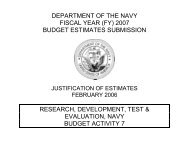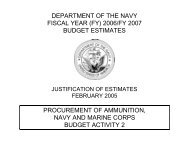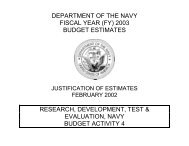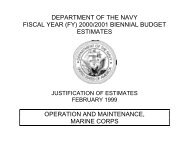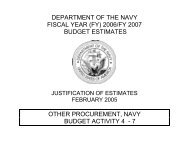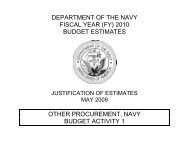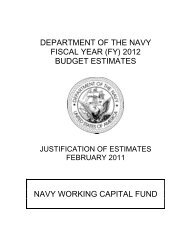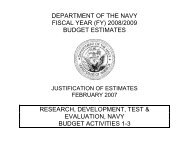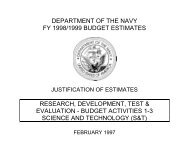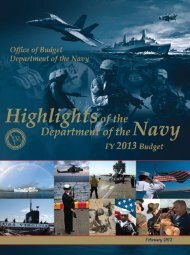Budget Highlights Book - DON FM&C Website - U.S. Navy
Budget Highlights Book - DON FM&C Website - U.S. Navy
Budget Highlights Book - DON FM&C Website - U.S. Navy
You also want an ePaper? Increase the reach of your titles
YUMPU automatically turns print PDFs into web optimized ePapers that Google loves.
Rebalancing to Meet Priorities February 2010austere environments, and with forces designed to efficiently scale up ordown in size whenever necessary. By continuing to invest in the inherentflexibility of our Naval forces, we will continue to provide joint forcecommanders with multiple options to project, protect, and influence.• Supporting overseas contingency efforts with Individual Augmentees (IAs).The <strong>Navy</strong> provides approximately 15,600 sailors in the form of IA’s,including 3,800 personnel in the training pipeline, to fulfill the OCO missionrequirements of the Combatant Commanders (COCOM). Approximately8,500 of these IA’s are funded in the baseline budget filling core missions suchas maritime and port security, airlift support, and JTF/COCOM staff support.An additional 2,700 IA’s are funded in the baseline budget in support ofadaptive core missions including Counter IED, Combat Support, MilitaryPolice, Base Operations, Intel and Medical. The overseas contingencyrequest includes 4,400 over strength requirements for temporary <strong>Navy</strong>overseas IA missions such as civil affairs, provincial reconstruction, trainingteams, detainee operations and customs inspections. IAs are making asignificant impact in more than 20 countries around the world. They areassigned individually, rather than as part of a traditional unit, to fill shortagesor provide specialized knowledge or skill sets. IAs have been assigned inAfghanistan, Iraq, Kuwait, Djibouti, Liberia, Chad, Cuba, Bahrain, Qatar,Colombia, Philippines, United Arab Emirates, Sudan, Oman, Pakistan,Germany, Spain, Italy, Honduras, Panama, Peru, Trinidad and Tobago, andHaiti. These IA’s provide commanders with mission‐tailored, globallydistributed forces. The <strong>Navy</strong> identifies both active and reserve servicemembers with specific skill sets to fill IA roles, and the Marine Corps reliesprincipally on activated reserve members to fill IA positions vacated byforward‐deployed active component Marines.• The <strong>Navy</strong>‐Marine Corps team. The Department of the <strong>Navy</strong> continues toshape the force to balance today’s missions and to provide flexibility for thefuture. The Marine Corps has accomplished its goal of growing the force to202,100 Marines. This initiative will help to provide our Marines greaterdwell time and will provide the opportunity to address other training andmissions that have not been accomplished in our recent history. Both the<strong>Navy</strong> and Marine Corps are meeting their recruiting goals both in quantityand quality. Our reserves continue to play a key role as part of the TotalForce and our civilians are a bedrock providing support around the globe toour warfighters. Development and retention of quality people are vital to our1‐10 FY 2011 Department of the <strong>Navy</strong> <strong>Budget</strong>



